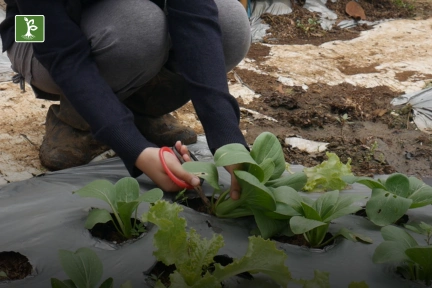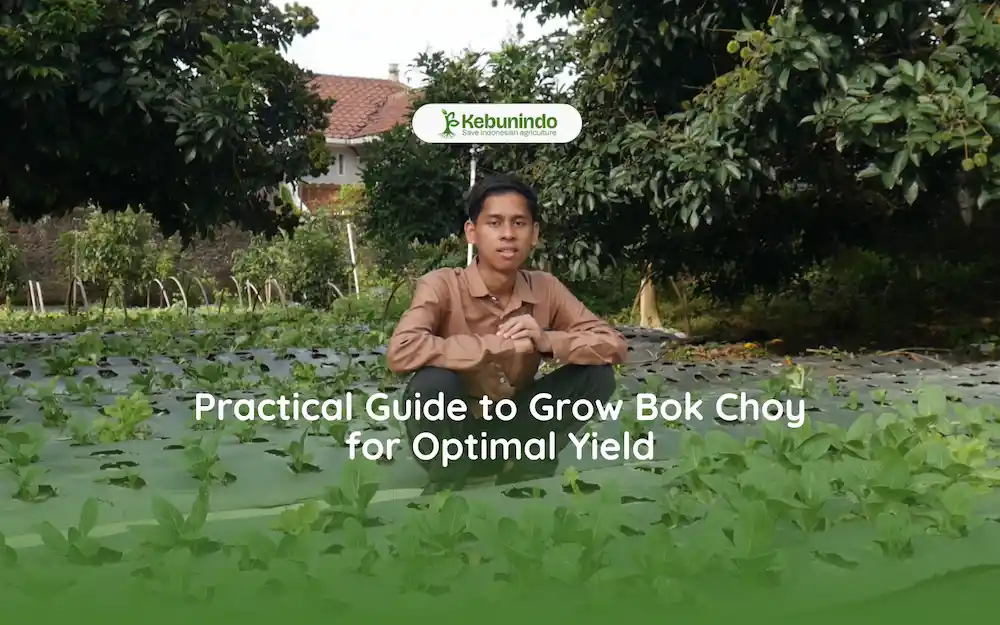1. Selection of the Right Variety
A very important first step in cultivating pak choy is choosing a variety that suits the environmental conditions in the area where you are cultivating. Choosing the right variety not only affects plant growth but also the harvest results obtained.
Some varieties of pak choy that are popular in Indonesia include Nauli F1, Green Pakcoy, and White Pakcoy, each has its own advantages in terms of adaptation to climate, productivity, and resistance to pests or diseases.
Before determining a variety, it is important to understand environmental characteristics, such as temperature, humidity and soil type, so that plants can grow optimally and provide maximum results.
2. Land Preparation

Planting pak choy plants requires attention to land conditions to ensure optimal growth. The land preparation process is a very important initial stage to create a fertile planting environment and support maximum plant development.
Good soil cultivation not only increases fertility, but also improves the soil structure so that it is more loose and absorbs water easily. The following steps can be followed in preparing the land for planting:
- Clear land: Make sure the land is free from weeds, rocks, or other plant debris that can inhibit the growth of pak choys. Clearing the land helps create optimal conditions for plant root development.
- Loosen the soil: Use a hoe or tractor to loosen the soil to a depth of 20-30 cm. This process helps increase air circulation and water absorption in the soil, thereby supporting the growth of pak choy roots.
- Check soil pH: If the soil pH is less than 6, add dolomite lime at a dose of 1.5 tonnes/hectare or 150 grams/m2. Spread the dolomite over the surface of the soil and let it soak for 2-4 weeks before planting. This step aims to increase soil fertility and balance the pH to suit the needs of the pak choy plant.
- Make a bed: Form a bed with a width of 100-120 cm, a height of 30 cm, and a distance between the beds of around 30 cm. This bed helps regulate drainage and prevents waterlogging which can damage plant roots.
- Use mulch: Cover the bed with plastic mulch or organic mulch. The use of mulch functions to prevent the growth of weeds, maintain soil moisture, and reduce the risk of soil erosion due to rain.
3. Basic Fertilization
Basic fertilization is an important step in preparing land for cultivating plants, including pak choy. Before the planting process begins, the soil needs to be given additional nutrients using organic fertilizer to increase its fertility.
One type of fertilizer recommended is manure, which is rich in essential nutrients. This fertilizer can be applied at a dose of 1 kg/m2 spread evenly over the surface of the bed. This process not only improves soil structure, but also helps create optimal conditions for plant root growth, so that harvest results are maximized.
4. Seeding
The seeding process is a very important first step to ensure the growth of healthy and strong seedlings before being transferred to the main land. This step involves special care so that the seeds can germinate well and produce optimal plants.
- Soaking Seeds: Soak bok choy seeds in warm water (around 40°C) for 12-24 hours. This step aims to speed up the germination process by softening the seed coat.
- Planting Media Preparation: Prepare planting media in the form of a mixture of loose soil and organic fertilizer in a ratio of 2:1. Planting media can be placed in seedling beds, polybags, or seedling trays according to availability. Make sure the planting medium is wet enough by watering it first.
- Seed Planting: Make small holes 1-2 cm deep in the planting medium, then insert one seed into each hole. Cover it back thinly with soil, then sprinkle with water slowly to maintain moisture.
- Seedling Care: Place the seedling media in a shady place but still exposed to indirect sunlight. Make sure the medium remains moist with regular watering, but avoid standing water which can cause seed rot.
- Sowing Time: Let the seeds grow into seedlings for 2-3 weeks until they have 2-3 true leaves. Healthy and strong seedlings are ready to be moved to the main planting area.
5. Transplanting

Transplanting pak choy is an important stage in cultivation which is carried out after the seedlings are 2-3 weeks old or have 3-4 leaves. At this stage, the seeds selected must be quality seeds, with stems that grow upright, fresh green leaves, and free from pests and diseases.
Before planting, make sure the bed is watered first to maintain soil moisture. Next, make planting holes with a distance of 30 x 30 cm to provide sufficient space for the growth of the seeds.
The seeds are carefully moved along with the planting medium from the nursery into the planting hole. Planting should be done in the morning or evening, so that the plants do not experience stress due to exposure to direct sunlight.
6. Regular Watering
During its growth period, pak choy plants need an adequate water supply to support the photosynthesis process and maintain soil moisture. Watering should be done regularly, especially in the morning and evening when the air temperature is cooler, to avoid rapid evaporation of water.
It is important to water carefully, using techniques that do not erode the soil or damage the plant roots. In this way, pak choy will grow healthy, strong and produce maximum results.
7. Weeding
Weeds that grow around pak choy plants can compete for water, light and nutrients, thereby disrupting the development of the main plant. Therefore, weeding must be done regularly, ideally 2-4 times during the cultivation period.
This weeding not only helps reduce competition between plants and weeds, but also prevents the spread of diseases that can be caused by weeds. Through regular weeding, pak choy plants will get enough space to grow healthily and optimally, producing a quality harvest.
8. Follow-up Fertilization
Additional fertilization is an important step in supporting plant growth after the first planting period. This process is carried out about two weeks after planting to ensure the plants get enough nutrition, especially the nutrients needed to grow optimally.
Additional fertilization can be done by adding urea fertilizer as much as 100 kg/hectare or using NPK Mutiara as much as 50 kg/hectare. The aim of providing this fertilizer is to meet the needs of nitrogen, phosphorus and potassium which support the process of photosynthesis, rooting and the formation of quality fruit or produce.
9. Control Pests and Diseases

Controlling pests and diseases in pak choy plants is an important step to maintain crop quality and yields. Pests that often attack pakcoy include aphids (Aphis sp), armyworm (Spodoptera litura), leaf caterpillars (Plutella xylostella), and leafminer flies (Liriomyza brassicae).
In addition, diseases that can threaten this plant include damping off of seedlings, leaf rot, and clubroot. To overcome this problem, control can be carried out using plant-based pesticides which are more environmentally friendly, or chemical pesticides for faster effectiveness.
Choosing the right control method is very important to minimize damage to plants and ensure continued healthy and optimal pak choy production.
10. Harvest

Pakchoy can be harvested after around 25-35 days after planting (DAT), with the characteristics of plants that are ready to be harvested including mature leaves that are wide oval in shape, bright green leaf stalks, and a relatively short plant height, around 20-35 cm .
The process of harvesting pak choy can be done using two methods, namely cutting the base of the leaves using scissors or removing the plant and its roots directly from the ground. The choice of harvesting method can be adjusted to market conditions and needs, so that the harvest remains optimal and of high quality.
11. Post-Harvest
After harvesting pak choy, there are several important steps that need to be carried out to maintain optimal quality before being marketed. First, trimming or pruning is done by removing wilted pak choy leaves, so that only fresh leaves remain.
Furthermore, cleaning This is done by cleaning the pak choy from any remaining soil or dirt attached to it, ensuring that the harvest is free from contamination. After that, the bok choy needs to be dried by airing it, so that it is not too wet and prevents mold growth.
The next process is sorting, namely separating bok choy that is still fit for sale from those that are damaged or not up to standard. Finally, sorted bok choy must be stored in a cool place and protected from direct sunlight, to maintain its freshness for a longer time.
By following these post-harvest stages, the quality of the pak choy will be maintained, so it is ready to be marketed at a better price.




